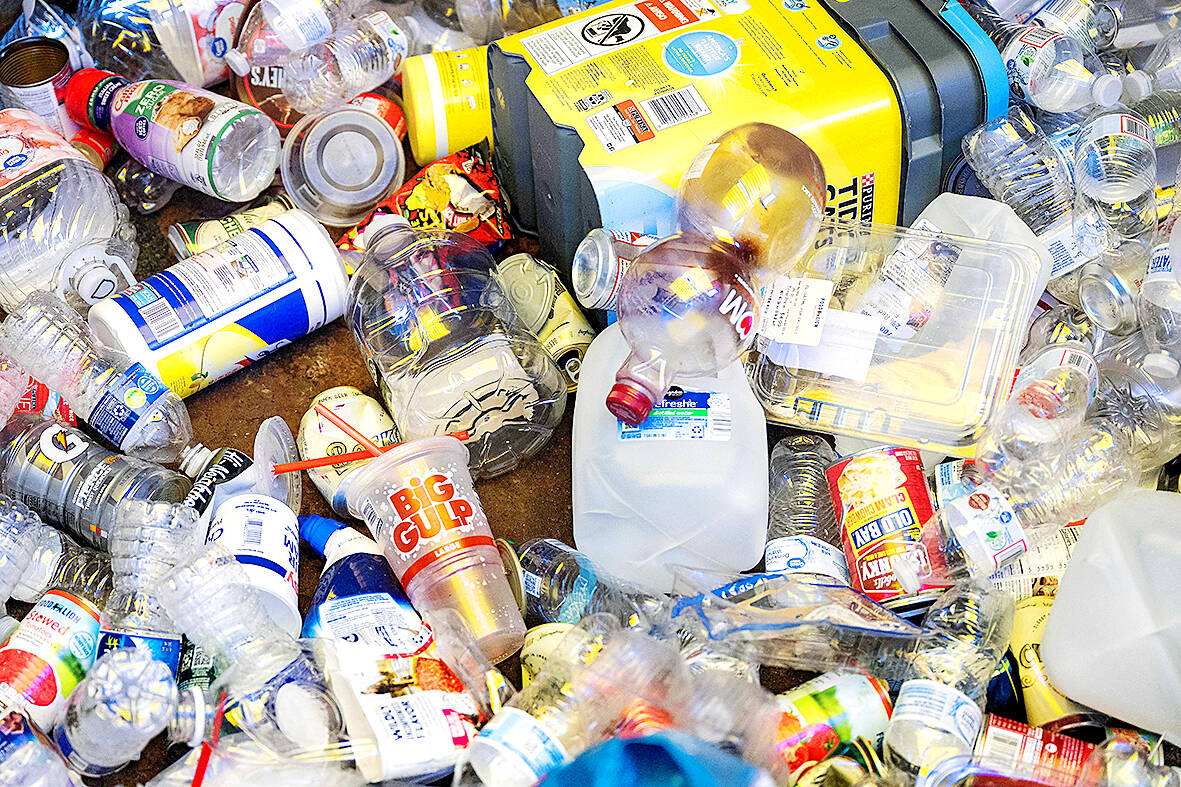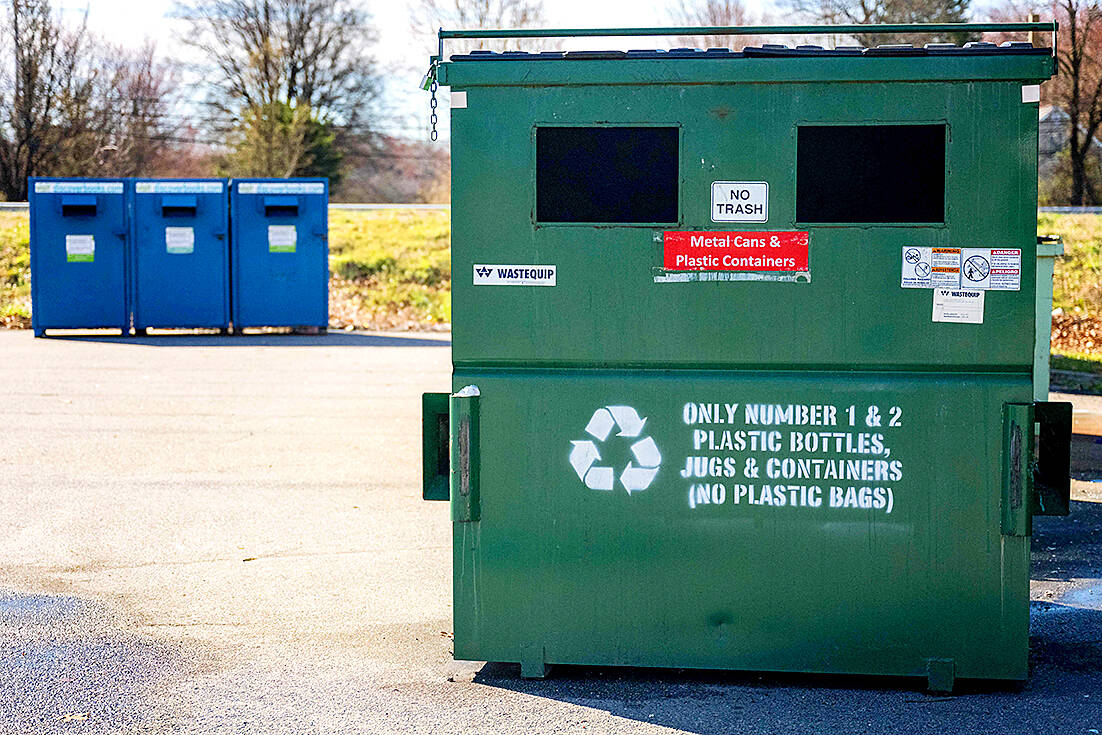In Uganda’s Mbale district, famous for its production of arabica coffee, a plague of plastic bags locally known as buveera is creeping beyond the city.
It’s a problem that has long littered the landscape in Kampala, the capital, where buveera are woven into the fabric of daily life. They show up in layers of excavated dirt roads and clog waterways. But now, they can be found in remote areas of farmland, too. Some of the debris includes the thick plastic bags used for planting coffee seeds in nurseries.
Some farmers are complaining, said Wilson Watira, head of a cultural board for the coffee-growing Bamasaba people.

Photo: AFP
“They are concerned — those farmers who know the effects of buveera on the land,” he said.
Around the world, plastics find their way into farm fields. Climate change makes agricultural plastic, already a necessity for many crops, even more unavoidable for some farmers. Meanwhile, research continues to show that itty-bitty microplastics alter ecosystems and end up in human bodies. Scientists, farmers and consumers all worry about how that’s affecting human health, and many seek solutions. But industry experts say it’s difficult to know where plastic ends up or get rid of it completely, even with the best intentions of reuse and recycling programs.
According to a 2021 report on plastics in agriculture by the UN Food and Agriculture Organization, soils are one of the main receptors of agricultural plastics. Some studies have estimated that soils are more polluted by microplastics than the oceans.

Photo: AFP
“These things are being released at such a huge, huge scale that it’s going to require major engineering solutions,” said Sarah Zack, an Illinois-Indiana Sea Grant Great Lakes Contaminant Specialist who communicates about microplastics to the public.
STUDYING MICROPLASTICS
Micro-particles of plastic that come from items like clothes, medications and beauty products sometimes appear in fertilizer made from the solid byproducts of wastewater treatment — called biosolids — which can also be smelly and toxic to nearby residents depending on the treatment process used. Some seeds are coated in plastic polymers designed to strategically disintegrate at the right time of the season, used in containers to hold pesticides or stretched over fields to lock in moisture.
But the agriculture industry itself only accounts for a little over 3 percent of all plastics used globally. About 40 percent of all plastics are used in packaging, including single-use plastic food and beverage containers.
Microplastics, which the National Oceanic and Atmospheric Administration defines as being smaller than five millimeters long, are their largest at about the size of a pencil eraser. Some are much smaller.
Studies have already shown that microplastics can be taken up by plants on land or plankton in the ocean and subsequently eaten by animals or humans. Scientists are still studying the long-term effects of the plastic that’s been found in human organs. Early findings suggest possible links to a host of health conditions including heart disease and some cancers.
Despite “significant research gaps,” the evidence related to the land-based food chain “is certainly raising alarm,” said Lev Neretin, environment lead at the FAO, which is currently working on another technical report looking deeper into the problem of microplastic pollution in soils and crops.
A study out this month in the Proceedings of the National Academy of Sciences found that microplastics pollution can even impact plants’ ability to photosynthesize, the process of turning light from the sun into energy. That doesn’t “justify excessive concern” but does “underscore food security risks that necessitate scientific attention,” wrote Fei Dang, one of the study’s authors.
CLIMATE CHANGE
The use of plastics has quadrupled over the past 30 years. Plastic is ubiquitous. And most of the world’s plastic goes to landfills, pollutes the environment or is burned. Less than 10 percent of plastics are recycled.
At the same time, some farmers are becoming more reliant on plastics to shelter crops from the effects of extreme weather. They’re using tarps, hoop houses and other technology to try to control conditions for their crops. And they’re depending more on chemicals like pesticides and fertilizers to buffer against unreliable weather and more pervasive pest issues.
“Through global warming, we have less and less arable land to make crops on. But we need more crops. So therefore the demand on agricultural chemicals is increasing,” said Ole Rosgaard, president and CEO of Greif, a company that makes packaging used for industrial agriculture products like pesticides and other chemicals.
Extreme weather, fueled by climate change, also contributes to the breakdown and transport of agricultural plastics. Beating sun can wear on materials over time. And more frequent and intense rainfall events in some areas could drive more plastic particles running into fields and eventually waterways, said Maryam Salehi, an associate professor of civil and environmental engineering at the University of Missouri.
PLASTICS POLLUTION TREATY
This past winter, leaders from around the world gathered in South Korea to produce the first legally binding global treaty on plastics pollution. They didn’t reach an agreement, but the negotiations are scheduled to resume in August.
Neretin said the FAO produced a provisional, voluntary code of conduct on sustainable management of plastics in agriculture. But without a formal treaty in place, most countries don’t have a strong incentive to follow it.
“The mood is certainly not cheery, that’s for sure,” he said, adding global cooperation “takes time, but the problem does not disappear.”
Without political will, much of the onus falls on companies.
Rosgaard, of Greif, said that his company has worked to make their products recyclable, and that farmers have incentives to return them because they can get paid in exchange. But he added it’s sometimes hard to prevent people from just burning the plastic or letting it end up in fields or waterways.
“We just don’t know where they end up all the time,” he said.
Some want to stop the flow of plastic and microplastic waste into ecosystems. Boluwatife Olubusoye, a PhD candidate at the University of Mississippi, is trying to see whether biochar, remains of organic matter and plant waste burned under controlled conditions, can filter out microplastics that run from farm fields into waterways. His early experiments have shown promise.
He said he was motivated by the feeling that there was “never any timely solution in terms of plastic waste” ending up in fields in the first place, especially in developing countries.
Even for farmers who care about plastics in soils, it can be challenging for them to do anything about it. In Uganda, owners of nursery beds cannot afford proper seedling trays, so they resort to cheaply made plastic bags used to germinate seeds, said Jacob Ogola, an independent agronomist there.
Farmers hardest hit by climate change are least able to reduce the presence of cheap plastic waste in soils. That frustrates Innocent Piloya, an agroecology entrepreneur who grows coffee in rural Uganda with her company Ribbo Coffee.
“It’s like little farmers fighting plastic manufacturers,” she said.

That US assistance was a model for Taiwan’s spectacular development success was early recognized by policymakers and analysts. In a report to the US Congress for the fiscal year 1962, former President John F. Kennedy noted Taiwan’s “rapid economic growth,” was “producing a substantial net gain in living.” Kennedy had a stake in Taiwan’s achievements and the US’ official development assistance (ODA) in general: In September 1961, his entreaty to make the 1960s a “decade of development,” and an accompanying proposal for dedicated legislation to this end, had been formalized by congressional passage of the Foreign Assistance Act. Two

Despite the intense sunshine, we were hardly breaking a sweat as we cruised along the flat, dedicated bike lane, well protected from the heat by a canopy of trees. The electric assist on the bikes likely made a difference, too. Far removed from the bustle and noise of the Taichung traffic, we admired the serene rural scenery, making our way over rivers, alongside rice paddies and through pear orchards. Our route for the day covered two bike paths that connect in Fengyuan District (豐原) and are best done together. The Hou-Feng Bike Path (后豐鐵馬道) runs southward from Houli District (后里) while the

President William Lai’s (賴清德) March 13 national security speech marked a turning point. He signaled that the government was finally getting serious about a whole-of-society approach to defending the nation. The presidential office summarized his speech succinctly: “President Lai introduced 17 major strategies to respond to five major national security and united front threats Taiwan now faces: China’s threat to national sovereignty, its threats from infiltration and espionage activities targeting Taiwan’s military, its threats aimed at obscuring the national identity of the people of Taiwan, its threats from united front infiltration into Taiwanese society through cross-strait exchanges, and its threats from

March 31 to April 6 On May 13, 1950, National Taiwan University Hospital otolaryngologist Su You-peng (蘇友鵬) was summoned to the director’s office. He thought someone had complained about him practicing the violin at night, but when he entered the room, he knew something was terribly wrong. He saw several burly men who appeared to be government secret agents, and three other resident doctors: internist Hsu Chiang (許強), dermatologist Hu Pao-chen (胡寶珍) and ophthalmologist Hu Hsin-lin (胡鑫麟). They were handcuffed, herded onto two jeeps and taken to the Secrecy Bureau (保密局) for questioning. Su was still in his doctor’s robes at